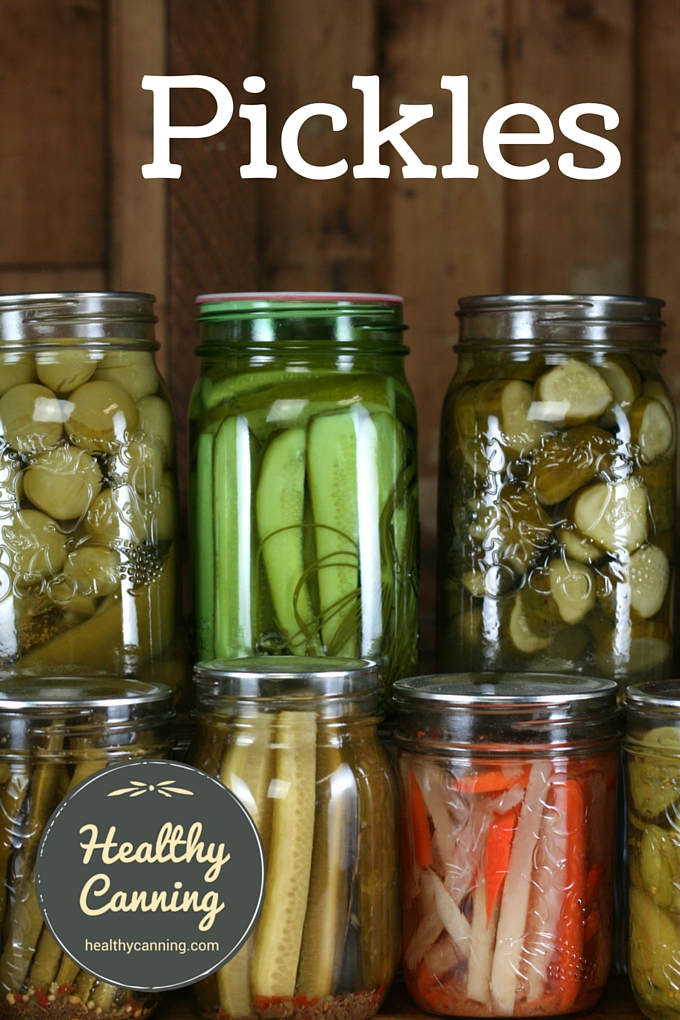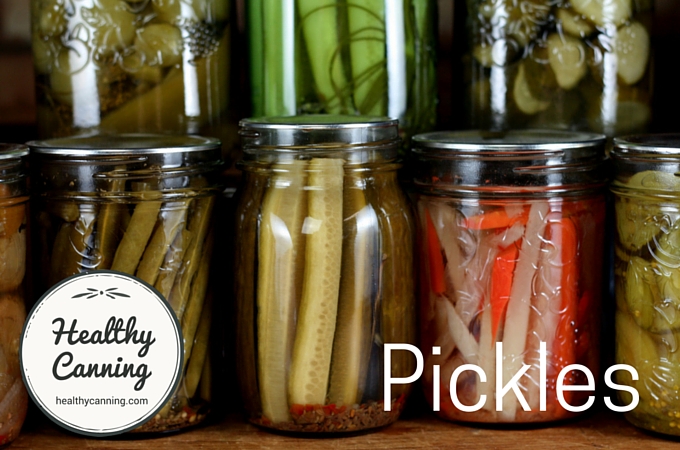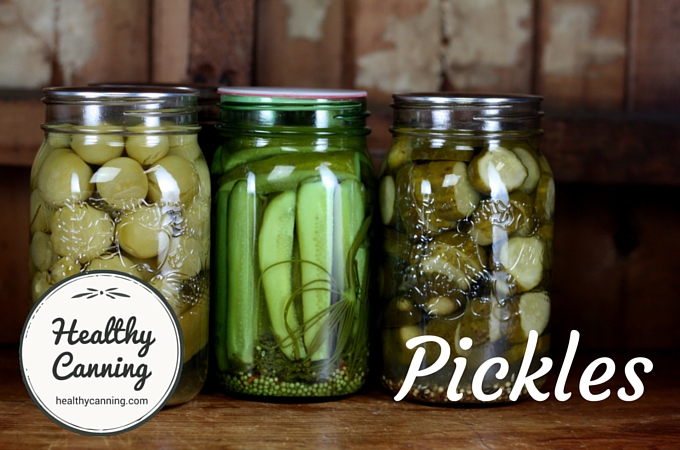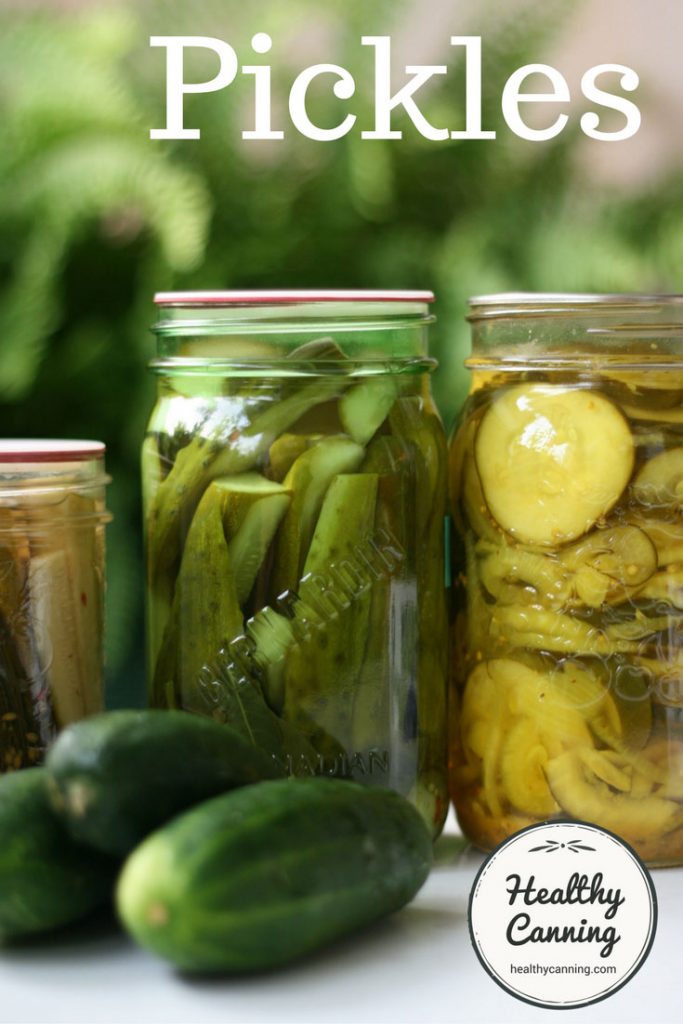Pickle recipes on healthycanning.com
See here for pickle recipes on healthycanning.com.
Not for beginners?
Beginners seem to be drawn to making pickles, as something that seems to be easy.
In fact, though, getting the knack for pickles right can actually be quite challenging, so much so that many pros advise newbies to hold off on pickles till they have mastered other aspects of home canning.
Alternative learning steps often suggested for beginners include relishes and jams.
Crisping pickles
The blossom ends of cucumbers contain enzymes that can cause your pickles to go soft. If you trim that end off, with just a very thin slice, the experts at the USDA and its university extensions say that you really shouldn’t need any of the old tricks such as adding a grape leaf, etc, beyond chilling the cucumbers first. Some though suggest you might also want to considering adding Pickle Crisp® (aka Calcium Chloride) to the jars.
See here for a full discussion on crisping pickles.
Pickles too sour?
If a pickle recipe comes out quite sour for your taste, don’t be tempted to dilute the vinegar with water (or more water than called for) the next time you make it. That would reduce the safety. Instead, there’s an easy way to fix the taste: just fool the taste buds by adding sweetener to mask some sourness.
The University of Georgia Extension Service says,
“If a less sour product [Ed: pickle] is preferred, add sugar [Ed: sweetener] rather than decrease the vinegar.” [1] Preserving Food: Pickled Products. University of Georgia Cooperative Extension Service. Page 2
Instead of sugar, you can use pure liquid stevia. Just remember a teaspoon of liquid stevia has the sweetening power of a cup of sugar, so perhaps work in ½ teaspoon increments, tasting as you go while preparing your pickling liquid.
Jars of pickles that didn’t seal after canning
If a jar of pickles doesn’t seal after the first round of water bath processing, it’s better to just refrigerate it and treat it as the first one you opened from that batch. Re-processing it through another water bath round will almost certainly make the pickle too soft:
“Unsealed jars of food need to be treated as fresh. The food can be eaten immediately, refrigerated or recanned. Recanning will make pickles softer.” [2] Preserving Food: Pickled Products. University of Georgia Cooperative Extension Service. Page 3
Reduced-salt or salt-free pickles
It is safe to make reduced-salt or salt-free pickles with one important exception that must be observed.
Here’s the advice from the USDA Complete Guide:
In the making of fresh-pack pickles, cucumbers are acidified quickly with vinegar…. While these pickles may be prepared safely with reduced or no salt, their quality may be noticeably lower. Both texture and flavor may be slightly, but noticeably, different than expected. You may wish to make small quantities first to determine if you like them.
However, the salt used in making fermented sauerkraut and brined pickles not only provides characteristic flavor but also is vital to safety and texture. In fermented foods, salt favors the growth of desirable bacteria while inhibiting the growth of others. Caution: Do not attempt to make sauerkraut or fermented pickles by cutting back on the salt required. [3]Pickles with reduced salt content. In: United States Department of Agriculture (USDA). Complete guide to home canning. Agriculture information bulletin No. 539. 2015. Page 1-28.
Further reading
Acidity of water and vinegar combinations in home canning
Low-Temperature Pasteurization Treatment
Zucchini (aka courgettes) instead of cucumbers for pickles
References






Peter
Really good article. Very concise with good information. I am interested in canning more and upgrading from water bath. I make jam and pickles and want to do more of that but perhaps branch out into other things. Is the steam canner more clean to use?
I am trying to learn about the sizes. My water bath can handle 7 quarts (or 7 pints, [or 7 cups]). That is adequate but sometimes I feel like I could use more space for canning.
My main question is – if I only have cucumbers for 5 quarts of pickles, can I use the 30 quart pressure canner for that smaller batch or is it full loads only?
Healthy Canning
You can use pressure canners as water bath canners, without bringing them to pressure of course! There is, as of 2019, no recommendation about minimum canner load for water bath canning, though there has been talk of exploring the topic on and off over the years. But as it stands now, there’s no minimum jar load recommendation.
Jalene
I just finished canning pickles using Ball’s ready made dill pickle seasonings. It says to use 5% acidity vinegar and I just realized my vinegar is 4%. Are my pickles bad
Healthy Canning
Please check with one of these Master Food Preserver help groups as to what to do.
Betsy
We did pickles last week, but didn’t do the water bath. They all sealed bbut 1, now she told me, maybe you better do the water bath, will this. be okay I’m afraid they are not going to be okay. What do you think k?
Healthy Canning
All jars of home preserves, pickles or otherwise, must be processed.
Joycleyn
Seeking info want to start a small bread & butter canning business I have cucumbers but very low on cash so I want to get all my data right so that I will not have to redo. really would like a list of all the basic equipment and material that I would need so that I can do a costing.
Great article
Thanks
Healthy Canning
Hi Joycleyn,
Interesting question, and great idea! Ask in this canning group on Facebook, that way you can get an idea of what is right for the jurisdiction you live in as well to be able to legally sell them. https://www.facebook.com/groups/2261906796/